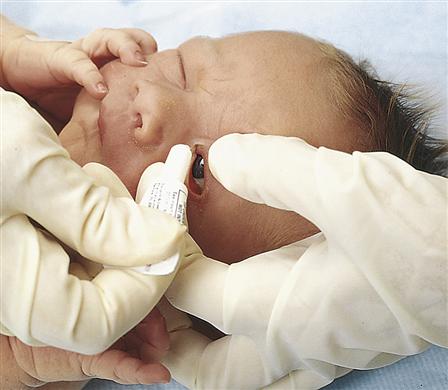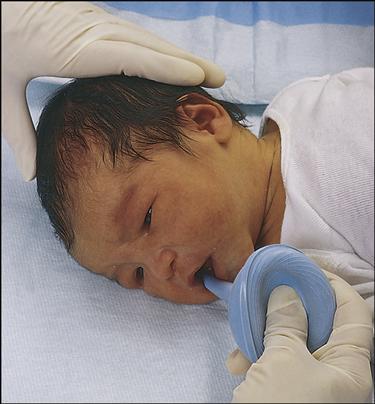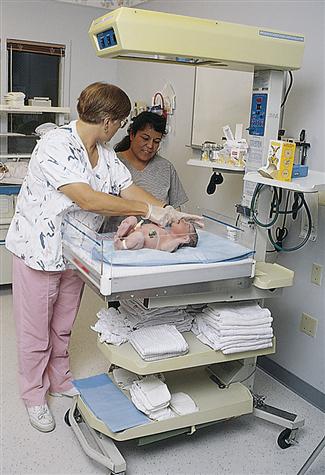The Normal Newborn: Nursing Care
Learning Objectives
After studying this chapter, you should be able to:
• Describe the purpose and use of routine prophylactic medications for the normal newborn.
• Describe collaborative interventions for hypoglycemia.
• Discuss prevention and parent teaching for jaundice.
• Explain the risks and benefits of circumcision.
• Describe the care of circumcised and uncircumcised male infants.
• Describe ongoing nursing assessments and care of the newborn.
• Describe methods to protect newborns by proper identification.
• Explain how nurses can help prevent infant abductions.
• Describe methods to prevent infections in newborns.
• Discuss important considerations in parent teaching.
• Explain the types and importance of newborn screening tests.
• Describe postdischarge nursing care included in home visits, clinic visits, and telephone follow-up.
![]()
http://evolve.elsevier.com/McKinney/mat-ch/
The nurse’s role in ongoing assessments and care of the newborn is to identify and respond to changes in the condition of newborns as they adapt to life outside the uterus, keep infants safe, and teach parents how to provide care.
Early Care
Early care after birth involves assignment of Apgar scores, assessment, and stabilization of the infant as necessary. Immediate care is discussed in Chapter 16, and infant resuscitation is discussed in Chapter 30. Assessment is discussed in Chapter 21. Once the infant is stable, prophylactic medications are given.
The nurse wears gloves during all contact with the infant until the bath is completed, because of blood and amniotic fluid on the infant’s skin from birth. After the bath, gloves are necessary only when contact with body fluids or stools will occur.
Administering Vitamin K
Because infants cannot synthesize vitamin K in the intestines without bacterial flora, they are deficient in clotting factors (Luchtman-Jones & Wilson, 2011). Vitamin K should be given to the neonate to prevent vitamin K–deficiency bleeding. One dose of vitamin K intramuscularly within the first hour after birth, prevents bleeding problems until the infant is able to produce the vitamin independently. Although the injection is usually given within an hour, it can be delayed until the infant has finished breastfeeding in the delivery room (American Academy of Pediatrics [AAP] & American College of Obstetricians and Gynecologists [ACOG], 2007). (See Chapter 38 for administration of injections to infants.)
Providing Eye Treatment
Newborns also receive prophylactic eye treatment to help prevent ophthalmia neonatorum in case the mother is infected with gonorrhea. Erythromycin (0.5%) ophthalmic ointment (Figure 22-1) is most commonly used. Tetracycline (1%) also may be used (AAP & ACOG, 2007). Because the ointment may temporarily blur the infant’s vision, the treatment may be given near the end of the first hour to allow for bonding with the parents.
In some infants, a mild inflammation develops a few hours after prophylactic treatment. Any discharge from the eyes, especially if it is purulent, should alert the nurse to the possibility of infection. Drainage should be removed with sterile saline and cotton. If the mother is infected, the infant needs additional antibiotics because routine prophylactic treatment may not completely prevent infection.
Nursing Care
Cardiorespiratory Status
In the early newborn period, problems of transition may include temporary problems in cardiorespiratory status.
Assessment
Assess the newborn for signs of difficult transition. Note the rate and character of the heart rate, pulses, respirations, and breath sounds. Look for signs of respiratory distress, including tachypnea, retractions, flaring of the nares, pallor or cyanosis, grunting, seesaw respirations, and asymmetry of chest movements (see Chapter 21).
Nursing Diagnosis and Planning
Fluid from the lungs must be removed by absorption or drainage from the respiratory passages after birth. This does not happen immediately and may cause a temporary problem during the early hours after birth. A common nursing diagnosis is:
Expected Outcome
The newborn will maintain a patent airway as evidenced by a respiratory rate within the normal range of 30 to 60 breaths per minute and show no signs of respiratory distress.
Interventions
Positioning and Suctioning
Position the infant on the back with the head in a neutral position or to the side. Use the bulb syringe as necessary to suction secretions as they drain into the infant’s mouth or nose (see Procedure: Using a Bulb Syringe). Suction the mouth first, because the infant may gasp and aspirate fluids in the mouth if
the nose is suctioned first (Kattwinkel, 2011). Suction the nose gently and only if necessary, because suctioning is traumatic to the tissues of the nose.
Keep the bulb syringe in the crib near the infant’s head, where it is available if needed quickly. Teach both parents how to use the bulb syringe correctly. Send the syringe home with the infant so the parents can use it if the infant experiences a problem.
If mechanical suctioning is necessary to remove deeper secretions, choose a small catheter to avoid damaging the tissues of the respiratory tract. Suction for no more than 5 seconds at a time using minimal negative pressure to avoid trauma, laryngospasm, and bradycardia. Apply suction only when the catheter is being withdrawn.
Providing Continuing Care
Continue monitoring the infant for problems throughout the birth facility stay. By the time of the second period of reactivity, the infant may be alone with the mother. Although nurses know that regurgitation, gagging, and brief episodes of cyanosis are normal during this time, these may be very frightening to the mother. Check frequently with her to see if the infant is having difficulty and provide needed instruction and assistance.
Evaluation
Nursing Care
Thermoregulation
Because any neonate may have difficulty with thermoregulation, the nurse must identify problems and intervene to prevent complications.
Assessment
Assess the newborn’s temperature according to agency policy. The temperature is often assessed every half hour until it has been stable for 2 hours. It is generally checked again at 4 hours and then every 8 to 12 hours. Assess the temperature more often if it is abnormal.
Nursing Diagnosis and Planning
Expected Outcome
The infant will maintain an axillary temperature within the normal range of 36.5° C to 37.5° C (97.7° F to 99.5° F).
Interventions
Preventing Heat Loss
Preparing the Environment Before Birth
Before the birth, prepare a neutral thermal environment with a radiant warmer to use during initial assessments (Figure 22-2). Check the radiant warmer to ensure it is functioning properly before the delivery. Turn it on early enough to warm the bed before the birth.
Providing Immediate Care
Immediately after birth, place the infant on the mother’s abdomen to provide warmth from skin-to-skin contact or under the radiant warmer to counteract the cool temperature of the delivery room. Routine assessment and care can be performed while the infant is on the mother’s abdomen and breastfeeding can begin, if the mother wishes and the mother and infant are stable.
Dry the wet infant quickly with warm towels to prevent heat loss by evaporation. Dry the hair well because the head has a large surface area and hair that remains damp increases heat loss. Remove towels or blankets as soon as they become wet, and replace them with dry, warmed linens. Cover the infant’s head with a cap when the infant is not under a radiant warmer. Do not use a hat when the infant is under the warmer because it prevents transfer of heat to the infant’s head.
Attach a skin probe to the abdomen when the infant is placed under a radiant warmer. Set the skin temperature for servocontrol between 36° C and 36.5° C (96.8° F and 97.7° F) (Brown & Landers, 2011). This setting regulates the amount of heat produced by the warmer to maintain the infant’s skin temperature at the normal level. Check frequently to see that the infant’s skin temperature is increasing as expected.
Providing Ongoing Prevention
To avoid conduction of heat away from the body, warm objects that come into contact with the infant. Pad cool surfaces such as scales before placing infants on them. Warm stethoscopes and clothing before using them. Before touching the infant, run warm water over your hands if they are cold.
To prevent heat loss by radiation in cold weather, position the newborn’s crib or incubator away from walls or windows that are part of the outside of the building. When the objects and air around the infant seem warm, it is easy to overlook the fact that infants lose heat to objects not in close contact with them. Keep this possibility in mind when positioning cribs in mothers’ rooms, which are often short of space. Place the crib between the beds (in a two-bed room) or near the head of the mother’s bed and away from windows or doors, if possible. Avoid areas with drafts such as near hall doors or air conditioners. Keep traffic low around radiant warmers, because movement increases air currents.
When assessing or caring for newborns, avoid exposing more of their bodies than necessary. Remove clothing and blankets only from areas being assessed. Keep the upper part of the body covered when changing diapers. Wrap infants in blankets, and use a stockinette or insulated hat to prevent heat loss from the large surface area of the head.
Restoring Thermoregulation
If an infant with a previously normal temperature develops a low temperature, institute nursing measures to assist thermoregulation immediately. If the axillary temperature is low, some nurses check the rectal temperature to determine core temperature. However, the process of nonshivering thermogenesis begins before the core temperature becomes abnormal. Core temperature changes indicate that the infant’s thermoregulatory resources are exhausted. Nurses must intervene before this happens.
Correct obvious causes first. The infant may be unwrapped or wearing wet clothing. The mother’s room may be cold, or the crib may be placed near the air conditioner.
A small drop in temperature can be remedied by placing the infant, dressed in only a diaper and hat, next to the mother’s bare skin. This skin-to-skin contact is very effective in using the mother’s body to warm the infant. Place a warm blanket over both mother and infant.
If skin-to-skin contact is not possible, put a shirt on the infant upside down by placing the infant’s legs in the sleeves for added warmth. Use two warmed blankets, each wrapped separately around the infant, to increase insulation of heat by trapping air between the layers. Place another blanket over the infant in the crib, and a hat on the infant’s head.
A greater drop in temperature or a temperature that has not improved within an hour using skin-to-skin contact requires additional measures. Place the infant under a radiant warmer for a short time. Observe the infant carefully during rewarming because it may cause apnea in some infants (Sedin, 2011).
Performing Expanded Assessments
Expanded assessments are necessary whenever temperature is decreased in a newborn. Observe for signs of respiratory distress brought on by the additional oxygen requirement of nonshivering thermogenesis.
Because the cold infant uses more glucose to produce heat, test the blood glucose level when the temperature is abnormal. If the glucose is low, help the mother breastfeed or use formula. Warm colostrum or breast milk helps warm the infant.
Notify the physician or nurse practitioner if the infant does not respond to these measures. Place the infant in a radiant warmer or incubator for close observation until the temperature stabilizes. Because low temperature may be a sign of infection, observe for other signs of infection (Sedin, 2011).
Evaluation
Nursing Care
Hepatic Function
The major early assessments and care of the hepatic system are related to blood glucose levels and bilirubin conjugation.
Blood Glucose
Assessment
Assess all infants for risk factors and signs of hypoglycemia (see Chapter 21, p. 494). Perform screening tests for blood glucose according to signs exhibited and agency policy.
Nursing Diagnosis and Planning
For infants who have glucose levels below 40 to 45 mg/dL (or value used by agency policy), the collaborative problem Potential Complication: Hypoglycemia is appropriate. Patient-centered goals for hypoglycemia are not created because this problem requires collaboration between the nurse and the physician. Agency protocols usually allow the nurse to intervene for hypoglycemia and then notify the physician. Planning revolves around the nurse’s role in:
Interventions
Maintaining Safe Glucose Levels
Follow agency policy and physician orders regarding feeding infants with low glucose levels. A common practice is to feed infants if the glucose screening shows 40 to 45 mg/dL or less. Infants with severe hypoglycemia may need intravenous feedings to provide glucose rapidly. For most infants, breastfeeding or giving formula is sufficient. Glucose water alone is not recommended for newborns because the rapid rise in glucose results in increased insulin production, causing a further drop in blood glucose. Milk provides a longer-lasting supply of glucose.
Assist the breastfeeding mother with the first feeding. If she is unable to nurse the infant immediately (because of pain or exhaustion from delivery), feed the infant formula and help her breastfeed at the next feeding. Assist formula-feeding mothers to give the bottle. Explain the need for prompt feeding in infants with hypoglycemia.
Repeating Glucose Tests
Until glucose levels are stable, closely observe newborns who have shown signs of hypoglycemia. Repeat glucose screenings may be performed according to agency policy. Keep the physician or nurse practitioner aware of the newborn’s status. If the blood glucose does not remain at an adequate level, other causative factors are investigated. The infant may be transferred to an intensive care nursery for treatment, including intravenous feedings, until blood glucose is stabilized with oral feedings.
Providing Other Care
Watch for signs of other complications. Infants who do not have enough glucose may experience a drop in temperature that could lead to respiratory distress as oxygen is used for nonshivering thermogenesis. The parents will be distressed over the multiple heel sticks their infant must endure. Explain the importance of maintaining adequate blood glucose levels and why the tests and frequent feedings are necessary. Encourage parents to feed the newborn as instructed so that enough glucose is available to meet the infant’s needs.
Evaluation
Evaluate the collaborative interventions for hypoglycemia by noting the infant’s response to interventions and the presence or absence of continued signs of hypoglycemia.
Bilirubin
Elevated bilirubin levels are common in newborns. Infants who need treatment for hyperbilirubinemia are discussed in Chapter 30. Prevention, however, is an important aspect of care.
Assessment
Assess for jaundice by blanching the infant’s skin on the nose or sternum. Assess for jaundice every 8 to 12 hours along with vital signs. Determine how far down the body the jaundice extends. Because visual assessment of jaundice is unreliable to determine the degree of hyperbilirubinemia accurately, obtain transcutaneous bilirubin (TcB) or total serum bilirubin (TSB) measurements in any jaundiced infants. Compare the results to previous tests and to charts that show what is expected for the infant’s age.
Nursing Diagnosis and Planning
Hyperbilirubinemia may not occur until after infants are at home, especially if discharge was early. A nursing diagnosis for this situation is:
Expected Outcomes
Parents will identify methods of preventing or reducing jaundice when at home. Parents will identify and seek treatment for infants who develop jaundice or whose jaundice worsens when at home.
Interventions
Determine which infants are at increased risk for hyperbilirubinemia (see Chapter 21, p. 475). Pay particular attention to preterm and late preterm infants because parents may not realize the increased risk for jaundice.
Explain the significance of jaundice to parents, and show them how to assess for color changes in the skin. Answer parents’ questions about bilirubin testing and care.
Discuss the importance of adequate feedings to stimulate passage of stools and help prevent high levels of bilirubin in the infant. When a newborn is feeding poorly, determine the reasons and intervene appropriately. Help mothers wake sleepy infants to feed, and encourage them to spend extra time with an infant with a poor suck. Explain that giving water to jaundiced infants does not stimulate stool excretion and should be avoided.
If the infant is breastfeeding, evaluate the infant’s suck and the mother’s understanding of positioning and other techniques. Instruct mothers to nurse at least 8 to 12 times each 24 hours for adequate lengths of time. Assist mothers having difficulty to ensure infants are feeding well before discharge.
Instruct parents to contact their care provider if they see an increase in jaundice after discharge or if the infant is not eating well, voiding at least six times a day by the day 4, and is not producing stools appropriately (at least once daily for formula-fed infants; at least four stools daily for breastfed infants). Stress the importance of making and keeping follow-up appointments with the infant’s health care provider. Offer written materials about jaundice for the parents to take home. Provide materials that are in the parents’ language or use a translator for teaching to ensure understanding.
Continue to check the infant for jaundice during early clinic or home visits. Transcutaneous or serum bilirubin levels may be used to determine the degree of jaundice. Reinforce teaching about identification of jaundice and importance of feedings and stooling. Answer questions that have occurred to parents since discharge from the birth facility.
If an infant develops true breast milk jaundice, explain it to the parents. The mother who has been told she must discontinue breastfeeding for a day or two will be very concerned. Reassure her that her milk is adequate and not harmful to the infant. Help her maintain her milk supply by using a breast pump during the time the infant is taking formula.
Evaluation
Stay updated, free articles. Join our Telegram channel

Full access? Get Clinical Tree





